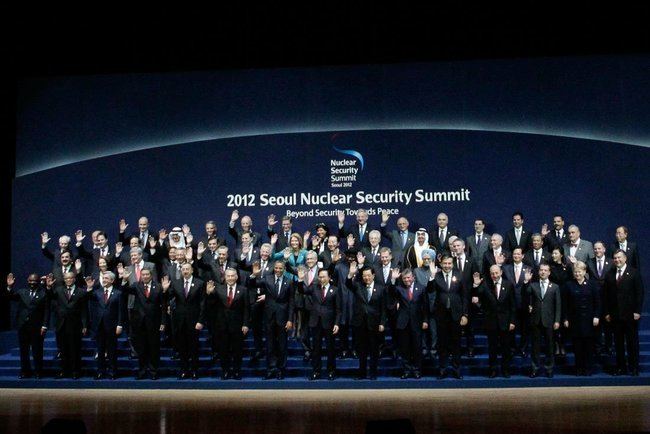Date March 26–27, 2012 Participants 58 representatives | ||
 | ||
Venue(s) COEX Convention & Exhibition Center Follows | ||
The 2012 Nuclear Security Summit was a summit held at the COEX Convention & Exhibition Center in Seoul, South Korea, on March 26 and 27, 2012. It was the second time the conference was held after the 2010 Nuclear Security Summit.
Contents
The summit series discusses international cooperative measures to protect nuclear materials and facilities from terrorist groups. Fifty-eight world leaders from 53 states and four international organizations, including the United Nations, International Atomic Energy Agency, the European Union and INTERPOL, participated. The main issues discussed were:
At the summit, the leaders discussed nuclear terrorism threats and nuclear security preparedness. They also reviewed the implementation of agreements and voluntary commitments. Then the leaders focused on major nuclear security issues, mostly brought up at the Washington summit, such as the minimization and management of highly enriched uranium, ratification of nuclear security conventions, strengthening information and transportation security, IAEA’s role, preventing illicit nuclear trafficking, nuclear security culture, and international cooperation and assistance.
In the aftermath of the Fukushima nuclear power plant accident in March 2011, Korea added the new issues of radiological security and nuclear security-safety interface to the agenda. The Washington summit had focused on nuclear terrorism with explosive nuclear devices, perceiving that as the biggest threat to international security. The 2012 Seoul summit also discussed protection against dirty bombs and the sabotage of nuclear facilities.
Some states opposed the two new items, saying that they would dilute the focus of the summit.
Background
The first Nuclear Security Summit was held in Washington D.C., USA on April 12 and 13, 2010. U.S. President Obama, who proposed the Nuclear Security Summit in his April 2009 Prague speech, invited 47 heads of states and three representatives of international organizations. In the Prague speech, President Obama announced his vision for a ‘world without nuclear weapons’ and proposed nuclear security as one of three strategic goals for this vision together with nuclear disarmament and nonproliferation. President Obama also announced a nuclear security goal to secure all vulnerable nuclear materials around the world in four years.
During the Washington summit, Korea was proposed as the second summit host by Present Obama, which was accepted.
Schedule and agenda
After a reception, on March 27 there was a Morning Session, a Working Luncheon and an Afternoon Session.
The agenda for each session was as follows:
1. March 26 (Monday) -Working Dinner : Review of the Progress Made Since the 2010 Washington Summit 2. March 27 (Tuesday) -Plenary Session I : National Measures and International Cooperation to Enhance Nuclear Security, including Future Commitments -Working Lunch : Nuclear Security-Safety Interface -Plenary Session II : National Measures and International Cooperation to Enhance Nuclear Security, including Future Commitments (cont.).
Seoul Communiqué
The Seoul Communiqué built on the objectives and measures set out in the 2010 Washington Communiqué to identify 11 areas of priority and importance in nuclear security and presents specific actions in each area.
The 11 areas are as follows: the global nuclear security architecture; the role of the IAEA; nuclear materials; radioactive sources; nuclear security and safety; transportation security; combating illicit trafficking; nuclear forensics; nuclear security culture; information security; and international cooperation.
The Seoul Communiqué sets out the following specific actions in the above 11 areas:
The Seoul Communiqué provides important timelines for advancing nuclear security objectives, such as the target year (end of 2013) for states to announce voluntary actions on minimizing the use of HEU and the goal year (2014) for bringing the amended CPPNM into effect. It reflects the need to address both the issues of nuclear security and nuclear safety in a coherent manner for the sustainable peaceful uses of nuclear energy. It also emphasizes the need to better secure spent nuclear fuel and radioactive waste. It also sets out specific measures to prevent radiological terrorism, an issue only briefly touched upon at the Washington Summit.
